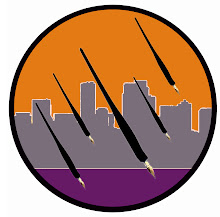I've been playing around with my writing method.
Until recently my writing practice has really been typing practice. A bit of hand sketching here and there, but almost exclusively I typed my stories into Scrivener from first drafts to last. I love Scrivener. I often have something of a mathematical formula for my stories (not the same formula, but each story has it's own pattern of interwoven POV, narrative, poetry hoo-ha) and Scrivener works well for the formalism I like to play with. So, again, I love Scrivener.
What I don't love is staring at a screen for so much of my day. And so I've been thinking about what it means to expand out beyond typing.
One help has been Jeff Vandermeer's Illustrated Guide to Creating Imaginative Fiction, Wonderbook. A great title, extremely evocative and inspiring illustrations, so much advice that I feel like I'm missing huge chunks of it. And so I'm reading very slowly and playing around with his advice.
Trying out notecards evolved into wondering more about the value of handwriting story. I loved Mark's recent blog about reading your work aloud; I very, very often do that and I think it has helped my writing have the right cadence. Reading out loud also gets more of the body involved in the writing; the breath, the throat, the tongue. For someone who thinks and writes a lot about body, that's a gift; I'm always looking for ways to integrate the mind and body more fully. And handwriting, too, seems to do that integration work as well.
Two events got me really thinking a lot about handwriting. I heard about some research concerning the value of handwriting in making neural connections in the brain, just as a friend sent me a blurb about a recent Lynda Barry book, Syllabus, in which she offers up her handwritten lessons from her writing workshops.
First the research, as summarized from The New York Times article: "When the children composed text by hand, they not only consistently produced more words more quickly than they did on a keyboard, but expressed more ideas." Now I'm a wicked fast typer, so I'm not sure whether or not I produce more words handwriting or typing, but that last part of the quote, about producing more ideas while handwriting, that gets my attention because I want my writing to be full of ideas. For me one of the joys of writing is to really explore ideas, even to come to them through the act of writing.
Now, Lynda Barry. Cartoonist, Novelist, Artist, Teacher. I love Lynda Barry. I once lived in a co-op house we called Marlys House after a favorite of Lynda Barry's characters. She is one of the reasons I am proud to be a human, that our species has produced this woman. Please if you have not read anything by her, do yourself a favor. Cruddy. One! Hundred! Demons! What It Is. Etc. Etc.
Lynda Barry is big on handwriting. Or better yet, she is big on playing with different ways of drawing words in order to get to your story. She is big on slowing down. She is big on using the hand. I love what she has to say about the creative connections between story and art. She didn't type her novel, Cruddy. She didn't write it with pencil and paper. She painted it. She used a paintbrush on legal paper. That's how she got her ideas down on paper. And it's a stunner. Read her thoughts about the process here.
My son goes to a Montessori school and every day they get to draw, but his teacher calls it "Work of the Hand." I love that phrase.
And I've been trying to do more of it. Practicing the work of the hand.
And it seems to be helping me re-invision what I have in the past thought of as my incredibly slow coming-to-new-story-ideas process. I now think I maybe just didn't have the right process for generating ideas. Instead I might all along have just needed to put a pen, pencil, (paintbrush?) in my hand and let that hand start to scrawl and scratch and those dark lines would be just the opening for ideas to seep and flow. Because that's exactly what they're doing, those ideas: seeping, flowing. Like a tight, selfish fist has relaxed, opened up and what wonders are written there on the palm.
I'm gonna try it some more, this old-style technology, this fancy handwriting. See where it might take me.
Next up ~ Shhhhh: the Role of Quiet.

